The South Caspian Basin (SCB) is an aseismic block that moves independently to its surroundings. Together with the Arabia-Eurasia collision, it controls the active tectonics of Turkmenistan. The directions, rates, and rotation poles of the SCB relative to Iran and Eurasia are not well resolved. In a new paper recently published in TECTONICS, we constrain the motion of the SCB by measuring the slip rate of the Main Kopeh Dagh Fault (MKDF) in Turkmenistan. Here’s what we found:
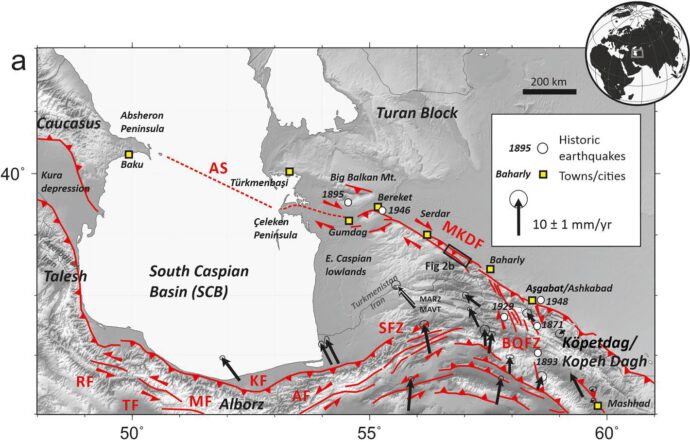
Plate motions
The relative motion between the SCB and surrounding parts of NE Iran and Turkmenistan is partly accommodated by the Shahroud left-lateral fault zone (SFZ) in Iran and the right-lateral MKDF in Turkmenistan. It is known that the SFZ has a left-lateral slip rate of 4.8 ± 0.8 mm/yr from GPS and InSAR data (Mousavi et al., 2015). The slip rate of the MKDF is more difficult to measure. Depending on which GPS to take, its right-lateral slip might be ∼3 mm/yr (Djamour et al., 2010) or 6.7 ± 0.5 mm/yr (Mousavi et al., 2013). Walters et al. (2013) used InSAR to measure a slip rate of 5–12 mm/yr.
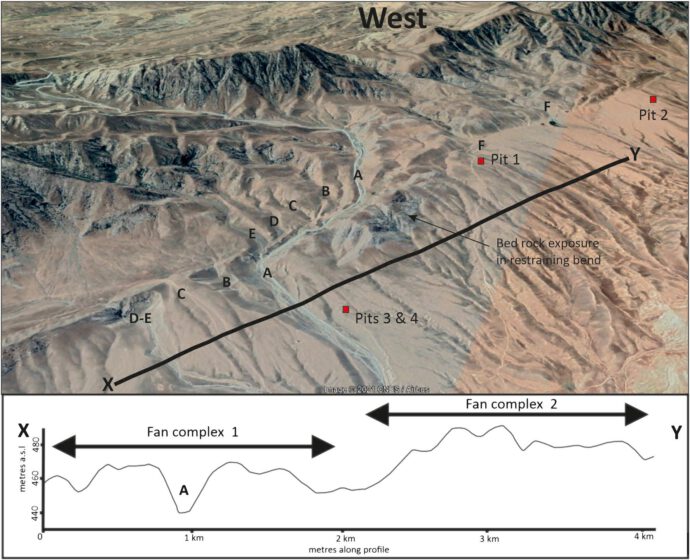
With a solid slip rate measurement on the MKDF, we would be able to better understand the motion of the entire South Caspian. Therefore, we targeted a system of incised alluvial fans that have recorded several hundreds of metres of lateral slip along the fault.

Slip rates
We dug pits into the surfaces of the fans and retrieved samples for luminescence dating. Although the dating turned out to be challenging, we got consistent ages of ca. 100 ka for the fans that are offset by 950 m. This means that the MKDF has a right-lateral rate of 9.1 ± 1.3 mm/yr (averaged over the last 100 ± 5 ka). The MKDF is one of the fastest faults in the entire Arabia-Eurasia collision zone! The slip rate is also compatible with the results derived from InSAR analysis.
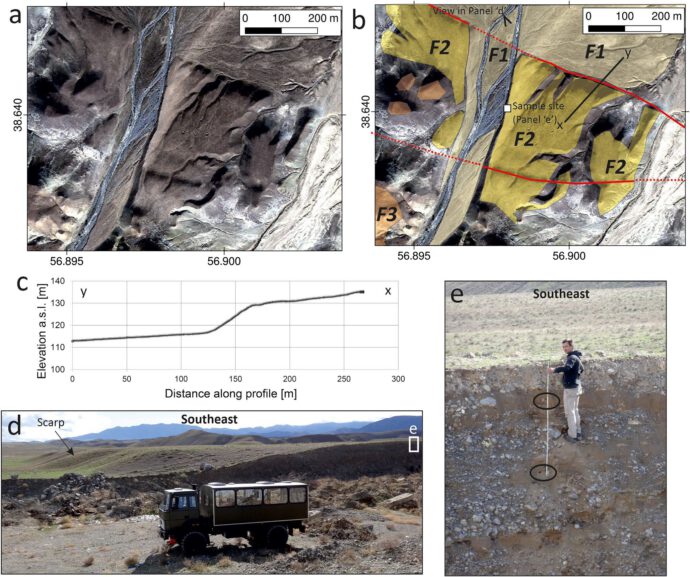
We also targeted a large cumulative fault scarp that recorded the shortening rate perpendicular to the fault. This scarp offsets alluvial fans by 12 m. Our luminescence samples returned ages of 35.6 ± 1.8 ka. Assuming a fault dip of 30–60°S (we do not have direct observations…) results in a shortening rate at the surface of 0.2–0.5 mm/yr, and slip along the fault plane would be 0.4–0.6 mm/yr. If the thrust flattens into a décollement at shallow depth, the overall rate of shortening is likely to be the same as the surface fault slip-rate. The uplift rate of 0.3 mm/yr that we estimate across the frontal thrust is hence a good minimum value for the overall shortening averaged over the last ~35 ka.
Implications for the motion of the South Caspian
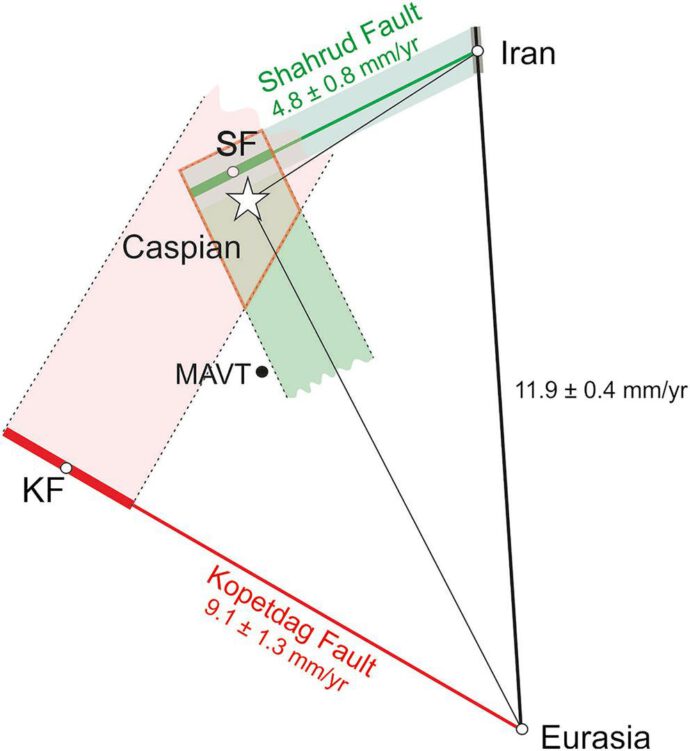
We can now construct a velocity triangle to analyse the motion of the SCB. The Iran-Eurasia motion is 11.9 ± 0.4 mm/yr (Khorrami et al., 2019). The strike-slip motion on the Shahrud Fault (SF) is 4.8 ± 0.8 mm/yr in direction 244° (Mousavi et al., 2015), shown by the green line in the figure above. We have shown that the strike-slip component of the MKDF is 9.1 ± 1.3 mm/yr toward 300° (red line, here named “KF”). We further know that the eastern Alborz and the western Köpetdag accommodate additional range-perpendicular shortening associated with SCB-Iran and SCB-Eurasia motion, respectively. The Caspian vertex must lie SSE of the SF in the green shaded area and NE of the MKDF in the pink shaded area. The overlap is outlined in red, with a star at its centre. This means that the SCB moves at 10.4 ± 1.1 mm/yr in direction 333° ± 5 relative to Eurasia and at 4.8 ± 0.8 mm/yr in direction 236° ± 14 relative to Iran.

The history of the South Caspian and motion along the Apsheron Sill
The slip rates that we have measured have some important implications for our understanding of the history of the SCB, too. When did the present tectonic regime start? Depending on the argument, several authors come up with ~2-5.5 Ma for the onset of the presently active tectonics (e.g., Devlin et al., 1999; Allen et al., 2003; Ritz et al., 2006; Green et al., 2009; Cifelli et al., 2015; Mattei et al., 2017, 2019). Hollingsworth et al. (2008) infer the onset of SCB expulsion at ∼10 Ma based on an assumed slip rate for the MKDF and a total geological offset along the MKDF of∼35 km. With our faster slip rate, this total displacement could have accumulated in 3-5 Ma if the slip rate was approximately constant over the last 3-5 Ma.
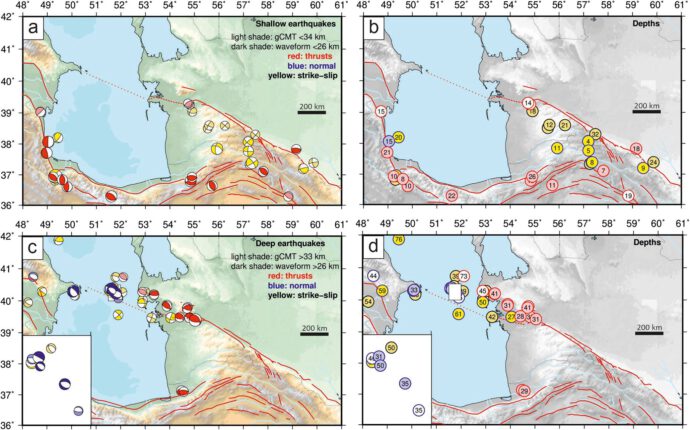
If this was correct, we can estimate the SCB-Eurasia motion across the Apsheron Sill to be ∼17–35 km orthogonal to the sill, and 22–45 km of right-lateral strike-slip parallel to it. These estimates are only approximations of course, but they suggest that faulting associated with the Apsheron Sill probably has a significant component of strike-slip.

References
- Allen, M. B., Vincent, S. J., Alsop, G. I., Ismail-zadeh, A., & Flecker, R. (2003). Late Cenozoic deformation in the South Caspian region: Effects of a rigid basement block within a collision zone. Tectonophysics, 366(3–4), 223–239. https://doi.org/10.1016/s0040-1951(03)00098-2
- Cifelli, F., Ballato, P., Alimohammadian, H., Sabouri, J., & Mattei, M. (2015). Tectonic magnetic lineation and oroclinal bending of the Alborz range: Implications on the Iran-Southern Caspian geodynamics. Tectonics, 34(1), 116–132. https://doi.org/10.1002/2014tc003626
- Devlin, W., Cogswell, J., Gaskins, G., Isaksen, G., Pitcher, D., Puls, D., et al. (1999). South Caspian Basin: Young, cool, and full of promise. Geological Society of America Today, 9(7), 1–9.
- Green, T., Abdullayev, N., Hossack, J., Riley, G., & Roberts, A. M. (2009). Sedimentation and subsidence in the south Caspian Basin, Azerbaijan. Geological Society, London, Special Publications, 312(1), 241–260. https://doi.org/10.1144/sp312.12
- Hollingsworth, J., Jackson, J., Walker, R., & Nazari, H. (2008). Extrusion tectonics and subduction in the eastern South Caspian region since 10 Ma. Geology, 36(10), 763–766. https://doi.org/10.1130/g25008a.1
- Jackson, J., Priestley, K., Allen, M., & Berberian, M. (2002). Active tectonics of the south Caspian basin. Geophysical Journal International, 148(2), 214–245. https://doi.org/10.1046/j.1365-246x.2002.01005.x
- Khorrami, F., Vernant, P., Masson, F., Nilfouroushan, F., Mousavi, Z., Nankali, H., et al. (2019). An up-to-date crustal deformation map of Iran using integrated campaign-mode and permanent GPS velocities. Geophysical Journal International, 217(2), 832–843. https://doi.org/10.1093/gji/ggz045.
- Mattei, M., Cifelli, F., Alimohammadian, H., Rashid, H., Winkler, A., & Sagnotti, L. (2017). Oroclinal bending in the Alborz Mountains (Northern Iran): New constraints on the age of South Caspian subduction and extrusion tectonics. Gondwana Research, 42, 13–28. https://doi.org/10.1016/j.gr.2016.10.003
- Mattei, M., Visconti, A. L., Cifelli, F., Nozaem, R., Winkler, A., & Sagnotti, L. (2019). Clockwise paleomagnetic rotations in northeastern Iran: Major implications on recent geodynamic evolution of outer sectors of the Arabia-Eurasia collision zone. Gondwana Research, 71, 194–209. https://doi.org/10.1016/j.gr.2019.01.018
- Mousavi, Z., Pathier, E., Walker, R. T., Walpersdorf, A., Tavakoli, F., Nankali, H., et al. (2015). Interseismic deformation of the Shahroud fault system (NE Iran) from space-borne radar interferometry measurements. Geophysical Research Letters, 42(14), 5753–5761. https://doi.org/10.1002/2015gl064440
- Mousavi, Z., Walpersdorf, A., Walker, R. T., Tavakoli, F., Pathier, E., Nankali, H. R. E. A., et al. (2013). Global Positioning System constraints on the active tectonics of NE Iran and the South Caspian region. Earth and Planetary Science Letters, 377, 287–298. https://doi.org/10.1016/j.epsl.2013.07.007
- Ritz, J. F., Nazari, H., Ghassemi, A., Salamati, R., Shafei, A., Solaymani, S., & Vernant, P. (2006). Active transtension inside central Alborz: A new insight into northern Iran–southern Caspian geodynamics. Geology, 34(6), 477–480. https://doi.org/10.1130/g22319.1
- Walker, R. T., Bezmenov, Y., Begenjev, G., Carolin, S., Dodds, N., Gruetzner, C., Jackson, J. A., Mirzin, R., Mousavi, Z., & Rhodes, E. J. (2021). Slip-rate on the Main Köpetdag (Kopeh Dagh) strike-slip fault, Turkmenistan, and the active tectonics of the South Caspian. Tectonics, 40, e2021TC006846. https://doi.org/10.1029/2021TC006846
- Walters, R. J., Elliott, J. R., Li, Z., & Parsons, B. (2013). Rapid strain accumulation on the Ashkabad fault (Turkmenistan) from atmosphere-corrected InSAR. Journal of Geophysical Research: Solid Earth, 118(7), 3674–3690. https://doi.org/10.1002/jgrb.50236



No Comments
No comments yet.